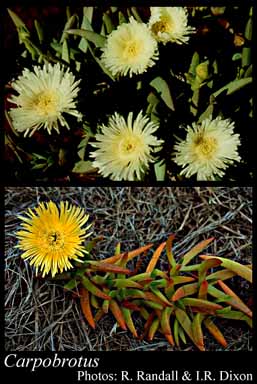- Reference
- Gard.Chron. p433 en clavi. (1925)
- Name Status
- Current

Scientific Description
Common name. Pigfaces. Family Aizoaceae.
Habit and leaf form. Shrubs (stem angled or ridged, prostate to 2m long, rooting at nodes). ‘Normal’ plants. Leaves well developed. Plants succulent. Leaves cauline. Stem internodes solid. Xerophytic. Leaves minute to medium-sized; opposite; fleshy; imbricate to not imbricate; shortly petiolate, or subsessile; slightly connate; simple; epulvinate. Leaf blades entire; triquetrous; ensheathing stem, leaf pairs slightly connate at base. Leaves without stipules. Leaf blade margins entire. Vegetative buds not scaly. Leaves without a persistent basal meristem. Leaf anatomy. Hairs absent. Urticating hairs absent. Extra-floral nectaries absent. Stem anatomy. Secondary thickening anomalous; via concentric cambia.
Reproductive type, pollination. Fertile flowers hermaphrodite. Unisexual flowers absent. Plants hermaphrodite. Entomophilous (diurnal).
Inflorescence and flower features. Flowers solitary. Inflorescences on short axillary shoots. Flowers pedicellate; ebracteate; ebracteolate; small, or medium-sized; regular; cyclic; pentacyclic to polycyclic. Free hypanthium present; includes calyx, staminodes and stamens. Perianth sepaline; 5. Calyx present; 5; 1 -whorled; gamosepalous; blunt-lobed (usually succulent); imbricate, or valvate (rarely); connate for short distance above summit of floral tube; regular; fleshy; persistent. Sepals outer 3 acutely angled like leaves. Corolla absent. Fertile stamens present. Androecial members indefinite in number. Androecium 100 (many). Androecial members branched (by dédoublement); maturing centrifugally; all equal; free of one another (staminode); 1–16 -whorled (i.e to ‘many whorls’). Androecium including staminodes. Staminodes 20–50 (in up to 5 whorls, narrow, petal-like, yellow or pink or purple or white); petaloid. Stamens 20–100 (in up to 9 whorls); all more or less similar in shape; reduced in number relative to the adjacent perianth (rarely), or isomerous with the perianth, or diplostemonous to polystemonous; staminodes inserted outside stamens; filantherous. Anthers dehiscing via longitudinal slits; introrse; tetrasporangiate. Pollen shed as single grains. Fertile gynoecium present. Gynoecium (1–)2–5(–20) carpelled. The pistil 6–15 celled. Gynoecium syncarpous; synovarious; inferior. Ovary plurilocular; 6–14(–15) locular. Gynoecium stylate. Styles 6–14 (to 15); apical. Stigmas 6–15. Placentation lower axile and parietal. Ovules 20–50 per locule (very numerous); arillate, or non-arillate; anatropous, or campylotropous.
Fruit and seed features. Fruit fleshy; indehiscent; a capsule, or a berry; 6–15 celled; 20–100 seeded (many). Seeds non-endospermic. Perisperm present (mealy). Embryo well differentiated. Cotyledons 2. Embryo curved.
Etymology. From the Greek meaning edible fruit.